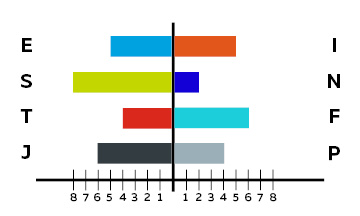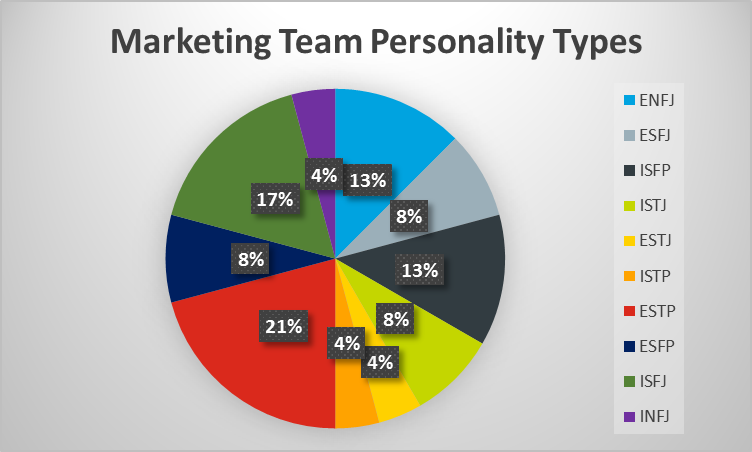Myers-Briggs Results – What Personalities Make Up Our Marketing Team?
.jpg)
The marketing team is made up of over 25 individuals who work in different groupings every day. Personality tests can help determine which individuals work best together, complement each other and what each personality’s strengths and weaknesses are. The Myers-Briggs personality test assesses four traits to determine your personality type. The test then assesses your personality’s dominant functions and function pairs (explained below).
Earlier this year, you all took a free version of the Myers-Briggs test. The below assessments show the results of that test. Please note that they are not 100% in line with the Myers-Briggs assessment, but are very close. In addition to assessing the 4-letter personality type, this test also branded your personality with an animal.
The assessment looks at the following personality traits:
Favorite world: Do you prefer to focus on the outer world or on your own inner world? This is called Extraversion (E) or Introversion (I).
Information: Do you prefer to focus on the basic information you take in or do you prefer to interpret and add meaning? This is called Sensing (S) or Intuition (N).
Decisions: When making decisions, do you prefer to first look at logic and consistency or first look at the people and special circumstances? This is called Thinking (T) or Feeling (F).
Structure: In dealing with the outside world, do you prefer to get things decided or do you prefer to stay open to new information and options? This is called Judging (J) or Perceiving (P).
Dominant Function
Everyone has a dominant function. We develop one of the four mental functions to a greater degree than any of the other three. This first and favorite function is like the captain of a ship, having the most important role in guiding us, and it becomes the type core of our conscious personality. This is called the dominant function. For the marketing team, the dominant function is Sensing.

Sensing is the most dominant trait among all of the individuals in the marketing team. This means that the majority of us pay attention to the physical reality - what we see, hear, touch, taste, and smell. We are concerned with what is actual, present, current, and real and notice facts and remember details. We prefer to see the practical use of things and learn best when we see how to use what we’re learning.
Functions develop by being used consciously and purposefully for things that matter. As the dominant is used, it becomes strengthened and differentiated from the other functions. We tend to have the most skills and conscious use of this function, and we tend to trust it the most.
Function Pairs
The two middle letters in the Myers-Briggs assessment are called Function Pairs. Together, these two letters form the individual’s general approach to life and work. For the marketing team, the most common function pair was SF (Sensing and Feeling) followed by ST (Sensing plus Thinking). This is interesting, as the two generally look at work performance in two distinct ways. SF individuals tend to approach life and work in a warm, people-oriented manner, where STs tends to approach life and work in an objective and analytical manner. The juxtaposition of these two function pairs blend nicely. The different approaches to work symbolize the ability of the marketing team to attack problems from every angle and not miss a way of looking at something.
The Breakdown

The below are the individual personality assessments.
Bear (ISFJ) - Courtney, Hoosh, Jenna S, Larry
The Bodyguard, The Humble Servant, The POW, The Caregiver
On the outside, the quiet, shy Bears have a strong resemblance to the gentle Butterflies. The Bears’ tendency to go with the flow is driven by loyalty to their loved ones. Bears have a strong backbone; one which they will readily display if they or their loved ones are in danger—in a Bear’s mind, the latter is more important—or if a value they hold dearly is being challenged.
Beaver (ISTJ) - Katrina, Stef
The Impartial Critic, The Workhorse, the Worrywart, The Patient Builder
Low-maintenance and industrious, Beavers are the quiet backbone of most, if not all, institutions. Beavers prioritize duty above all things, whether it is in their role as a parent, a boss, an employee, student body treasurer, or any position with even a modicum of responsibility. Beavers assume the role of inspector general, guardian to all of the rules and regulations that society is built upon.
Butterfly (ISFP) - Doug, James, Terra
The Free Spirit, The Master of Harmony, The Sensitive Pushover, The Artist
One part gentle, one part easy going, with more than a splash of space cadet, the Butterfly can defy all misconceptions of what it means to be an SP. Not as kinetic or aggressive as the Foxes and Sharks, or dramatic as the Peacock, the Butterfly is a more delicate breed of SP, relishing the simple pleasures of life as they come to them.
Dolphin (ENFJ) - Nora, Victoria, Viviana
The Community Organizer, the Teacher, the TMI Gal/Guy, The Diplomat
What sets Dolphins apart is the ease in which they can assimilate into society. The popular Dolphin is a paragon of social excellence. A Dolphin’s idealism is very grounded and thus, more accessible.
Elephant (ESFJ) - Lindsey, Melissa
Head of the Family, the Optimist, The Gossip, the Host
Rivaling the Peacock for the title of “The Most Extroverted Type”, Elephants are well known for their warmth, chattiness, and generosity. Elephants exude an easygoing friendliness, an air of social comfort that automatically enables those around them to feel comfortable.
Fox (ESTP) - Austin, Danielle, Jenny, Kate, Mark
The Improviser, The Deal Maker, The Madison Ave. Marketer, The Adventurer
Cocky, sly, smooth, and charming, Foxes have a natural confidence and grace. Foxes seem to attain their popularity effortlessly. In fact, everything about a Fox seems effortless, making them the perfect embodiment of “cool”.
Giant Panda (INFJ) - Laura
The Neurotic, The Bookworm, The Counselor, The Resolute Decision-Maker
You are the stereotypical underdog, the idealistic reformer plugging away in the trenches of a system in dire need of change. Your sensitivity and academic prowess are two traits that, though rarely receiving much popular acclaim, you use to great effect, counseling those previously thought to be inconsolable, and nudging slowly but surely towards progress a structure previously thought to be immovable.
Peacock (ESFP) - Lindsay, Jessica
The Performer, The Life of the Party, the Acrobat, The Hedonist
There is no type that shines brighter in the spotlight than the fun-loving, gregarious Peacock. All SPs love to be excited, but there are two that stand out for their capacity to fully appreciate the world’s sensory pleasures, and no one would ever confuse the flamboyant Peacock with its gentle sibling, the Butterfly. Peacocks demand to be seen and heard, and with their performing talents, they rarely have a problem achieving either.
Shark (ISTP) - Peter
The Specialist, The Hunter, The Action Hero
Sharks love to explore with their hands and their eyes, touching and examining the world around them with cool rationalism and spirited curiosity. Sharks are the most active of all the 16 types. People with this personality type are natural Makers, moving from project to project, building the useful and the superfluous for the fun of it, and learning from their environment as they go. They are very verbally concise with a very physical nature.
Stag (ESTJ) - Jenna C
The Authority Figure, the Compartmentalizer, The Inflexible Bureaucrat, The Natural Born Leader
Forceful, yet disciplined; aggressive, yet deferential to established authority; Stags are so influential and vital to the establishment of our society that they are often looked upon as the quintessential SJ. Stags embody the idea of community, teamwork, and order. Stags are natural leaders who believe they have a responsibility to ensure that every individual is on the same page when it comes to reaching a common objective; one that will benefit society in a practical way.
